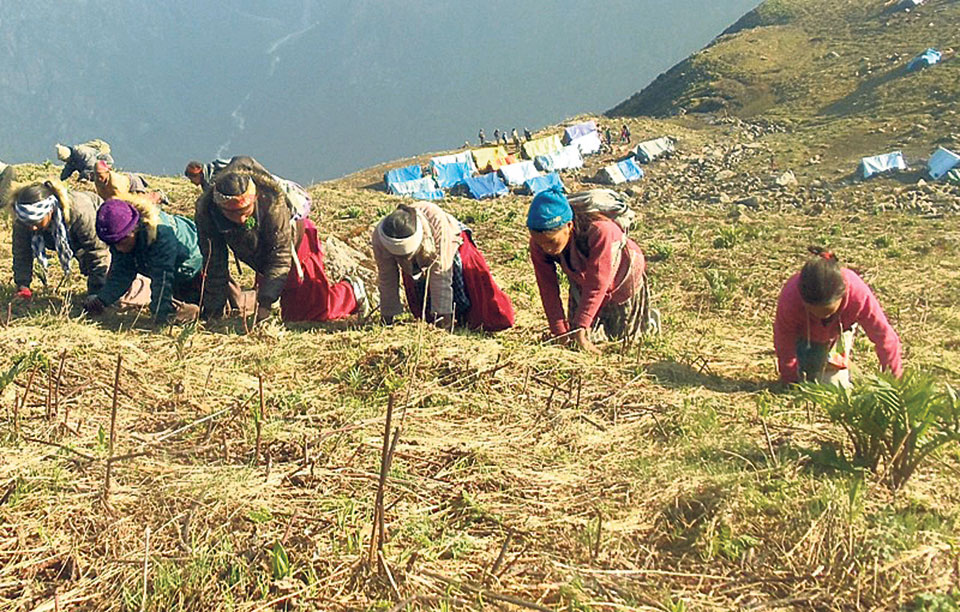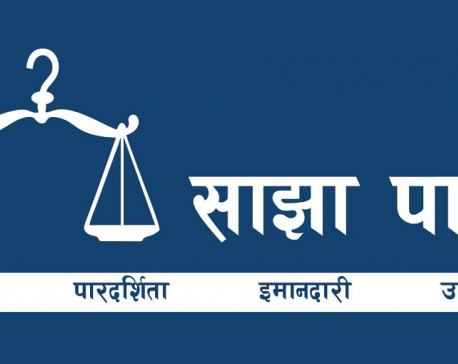
OR
Opinion
Harvesting yartsa gunbu during the pandemic
Published On: August 3, 2021 01:19 PM NPT By: Binaya Pasakhala and Kesang Wangchuk


Binaya Pasakhala and Kesang Wangchuk
The authors are affiliated with the International Centre for Integrated Mountain Development (ICIMOD)news@myrepublica.com
More from Author
Last year, due to the COVID-19 pandemic, the collection season coincided with the nation-wide lockdown. Many people were restricted from traveling to the collection sites, but some who live higher up and closer to these sites, disregarded the ban and proceeded with the collection.
The collection and trade of non-timber forest produce, and medicinal plants is an important livelihood strategy for mountain communities in Nepal. The caterpillar fungus, locally known as yartsa gunbu (literally: summer grass winter worm), found in the highlands of Nepal, is one of the most profitable medicinal species. Also known as the ‘Himalayan Gold’, the top quality yartsa gunbu can be more expensive than gold gram for gram when sold in Chinese markets. While the harvesting season for yartsa gunbu has ended for this year, the past two harvesting seasons during the COVID-19 pandemic have provided important lessons on sustainable harvesting, regeneration, and conservation and management of the collection sites.
Every year, between May and July, thousands of people across Nepal move to the highlands of twelve districts to collect yartsa gunbu. The collectors brave high altitudes, harsh mountain terrain, and inclement weather to collect this valuable species. For many families, the sale of yartsa gunbu is the major source of annual cash income to purchase food supplies, and pay for education, health, and other household expenses.
Last year, due to the COVID-19 pandemic, the collection season coincided with the nation-wide lockdown. Many people were restricted from traveling to the collection sites, but some who live higher up and closer to these sites, disregarded the ban and proceeded with the collection. In early 2021, when the pandemic appeared to have subsided, the situation looked promising and so did the possibility of a productive harvest season. Recognizing the significant link between yartsa gunbu and local livelihoods, a number of provincial and local governments decided to allow collection in the summer. But by mid-April, COVID-19 infections surged in Nepal. To curb the spread of the pandemic, the Government of Nepal declared another lockdown in various parts of the country, including in the mountain districts.
The lockdown combined with a surge in COVID-19 cases resulted in varying situations for yartsa gunbu collection at different locations. While districts such as Bajhang and Manang have allowed its collection with strict adherence to health protocols, local governments in Mustang and Mugu withdrew their decision to allow collection after a rise in the number of COVID-19 cases.
Implications of the ban on collection
Banning yartsa gunbu collection has implications for both the economy and the environment. It is an important economic opportunity, especially for poor households for whom it is a major source of cash income. Furthermore, amid the pandemic, many families lost their employment working as migrant labourers in India and in other countries. This has added to the economic burden of many poor families. The ban on yartsa gunbu collection also impacts local governments who rely on the revenues from permit fees to fund development activities such as health camps and salaries for temporary teachers. A number of mountain protected areas also depend on the royalty for their park management activities.
While the ban affects the livelihoods of those who depend on it, on the other hand, it can also help regeneration of the degraded alpine environment. Thousands of people gathering in the highlands within a span of two months can cause environmental degradation, particularly as a result of harvesting slow-growing alpine trees and shrubs for fuelwood, indiscriminate dumping of solid waste, and compacting the soil. Hence, the ban may have temporarily allowed the environment to regenerate and prevented the continued overharvesting of the caterpillar fungus.
Learning from Bhutan’s best practices
Given the recurring waves of the COVID-19 pandemic, there is a need to implement strategies to accommodate yartsa gunbu collection amidst the pandemic to support the livelihoods of collectors and provide much-needed revenue for local governments and protected areas, while inflicting minimal harm on the environment. A country that has successfully managed this and serves as a model of best practice is Bhutan.
In Bhutan, yartsa gunbu is collected from the country’s seven northern districts, with a few thousand people involved in collection each year. Unlike in Nepal, only residents of the respective districts are allowed to collect yartsa gunbu in Bhutan. Furthermore, collectors must strictly follow protocols related to harvesting, and campsite and waste management. In 2020, Bhutan allowed collection for one and a half months (May 15 to June 31), extending the normal collection period by one month, but with strict health protocols. The Royal Government of Bhutan prepared and implemented standard operating procedures (SOP) for collectors through relevant line agencies. A large number of forest guards were mobilized at the collection sites to monitor the collectors and ensure they followed the SOPs.
Good practices like the ones implemented in Bhutan during the pandemic can be very useful in Nepal. In line with COVID-19 prevention measures and to prevent any accidents or injuries, health and safety protocols and measures must be set in place, along with deploying adequate personnel to monitor collection sites. Collectors must also follow isolation measures after returning home from the collection sites. Furthermore, the government agencies, both local and provincial, should devise and restrict the number of collection permits as currently any number of collectors can acquire collection permits in Nepal without considering the carrying capacity of the collection sites.
A future for yartsa and the environment
Yartsa gunbu was officially declared a ‘threatened’ species by the International Union for Conservation of Nature (IUCN) last year, citing overharvesting and decline in its availability as the reasons. There is a clear need for Nepal to develop strategies to prevent overharvesting, improve management of the collection sites to minimize the impacts of the seasonal rush, and perhaps even close off heavily impacted sites for some time to allow for regeneration.
Furthermore, the COVID-19 pandemic is not the only challenge for collectors. Every year, they are exposed to numerous risks, such as natural disasters, illness and accidents. Despite such risks, the collectors travel to the high mountains to collect yartsa gunbu so that they can sustain themselves and their families. Therefore, government agencies must also implement diversified strategies that can help uplift the socio-economic conditions of poor mountain communities so that they have an alternate livelihood strategy before the last yartsa gunbu is harvested.
You May Like This

Jumla reports 39 new cases of coronavirus
JUMLA, Sept 2: At least 39 persons tested positive for novel coronavirus disease (COVID-19) in Jumla, officials said on Wednesday. Read More...

North Korea’s Kim marks war anniversary amid virus concerns
SEOUL, South Korea, July 27: North Korean leader Kim Jong Un has visited a national cemetery and handed out commemorative pistols... Read More...

Sajha Party concerned over govt's plan to give continuity to Constituency Development Fund
KATHMANDU, May 27: The Sajha Party has expressed serious concern over the government's plan to give continuity to funds to... Read More...









Just In
- Heavy rainfall likely in Bagmati and Sudurpaschim provinces
- Bangladesh protest leaders taken from hospital by police
- Challenges Confronting the New Coalition
- NRB introduces cautiously flexible measures to address ongoing slowdown in various economic sectors
- Forced Covid-19 cremations: is it too late for redemption?
- NRB to provide collateral-free loans to foreign employment seekers
- NEB to publish Grade 12 results next week
- Body handover begins; Relatives remain dissatisfied with insurance, compensation amount








Leave A Comment